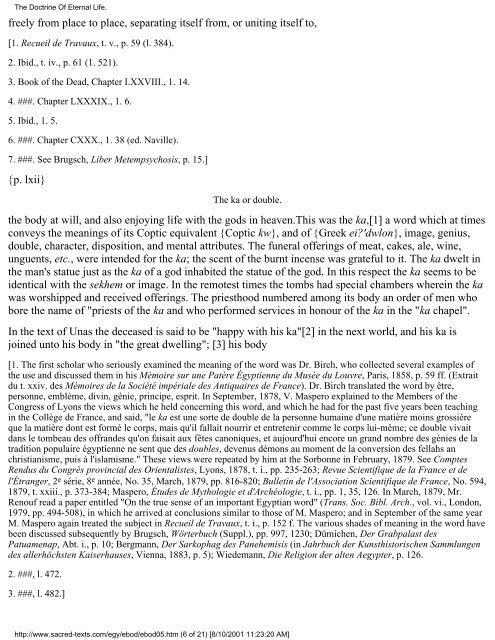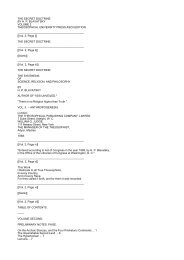Create successful ePaper yourself
Turn your PDF publications into a flip-book with our unique Google optimized e-Paper software.
The Doctrine Of Eternal Life.<br />
freely from place to place, separating itself from, or uniting itself to,<br />
[1. Recueil de Travaux, t. v., p. 59 (l. 384).<br />
2. Ibid., t. iv., p. 61 (1. 521).<br />
3. <strong>Book</strong> <strong>of</strong> <strong>the</strong> <strong>Dead</strong>, Chapter I.XXVIII., 1. 14.<br />
4. ###. Chapter LXXXIX., 1. 6.<br />
5. Ibid., 1. 5.<br />
6. ###. Chapter CXXX., 1. 38 (ed. Naville).<br />
7. ###. See Brugsch, Liber Metempsychosis, p. 15.]<br />
{p. lxii}<br />
The ka or double.<br />
<strong>the</strong> body at will, and also enjoying life with <strong>the</strong> gods in heaven.This was <strong>the</strong> ka,[1] a word which at times<br />
conveys <strong>the</strong> meanings <strong>of</strong> its Coptic equivalent {Coptic kw}, and <strong>of</strong> {Greek ei?'dwlon}, image, genius,<br />
double, character, disposition, and mental attributes. The funeral <strong>of</strong>ferings <strong>of</strong> meat, cakes, ale, wine,<br />
unguents, etc., were intended for <strong>the</strong> ka; <strong>the</strong> scent <strong>of</strong> <strong>the</strong> burnt incense was grateful to it. The ka dwelt in<br />
<strong>the</strong> man's statue just as <strong>the</strong> ka <strong>of</strong> a god inhabited <strong>the</strong> statue <strong>of</strong> <strong>the</strong> god. In this respect <strong>the</strong> ka seems to be<br />
identical with <strong>the</strong> sekhem or image. In <strong>the</strong> remotest times <strong>the</strong> tombs had special chambers wherein <strong>the</strong> ka<br />
was worshipped and received <strong>of</strong>ferings. The priesthood numbered among its body an order <strong>of</strong> men who<br />
bore <strong>the</strong> name <strong>of</strong> "priests <strong>of</strong> <strong>the</strong> ka and who performed services in honour <strong>of</strong> <strong>the</strong> ka in <strong>the</strong> "ka chapel".<br />
In <strong>the</strong> text <strong>of</strong> Unas <strong>the</strong> deceased is said to be "happy with his ka"[2] in <strong>the</strong> next world, and his ka is<br />
joined unto his body in "<strong>the</strong> great dwelling"; [3] his body<br />
[1. The first scholar who seriously examined <strong>the</strong> meaning <strong>of</strong> <strong>the</strong> word was Dr. Birch, who collected several examples <strong>of</strong><br />
<strong>the</strong> use and discussed <strong>the</strong>m in his Mèmoire sur une Patère Égyptienne du Musée du Louvre, Paris, 1858, p. 59 ff. (Extrait<br />
du t. xxiv. des Mémoires de la Société impériale des Antiquaires de France). Dr. Birch translated <strong>the</strong> word by être,<br />
personne, emblème, divin, génie, principe, esprit. In September, 1878, V. Maspero explained to <strong>the</strong> Members <strong>of</strong> <strong>the</strong><br />
Congress <strong>of</strong> Lyons <strong>the</strong> views which he held concerning this word, and which he had for <strong>the</strong> past five years been teaching<br />
in <strong>the</strong> Collège de France, and said, "le ka est une sorte de double de la personne humaine d'une matière moins grossière<br />
que la matière dont est formé le corps, mais qu'il fallait nourrir et entretenir comme le corps lui-même; ce double vivait<br />
dans le tombeau des <strong>of</strong>frandes qu'on faisait aux fêtes canoniques, et aujourd'hui encore un grand nombre des génies de la<br />
tradition populaire égyptienne ne sent que des doubles, devenus démons au moment de la conversion des fellahs an<br />
christianisme, puis à l'islamisme." These views were repeated by him at <strong>the</strong> Sorbonne in February, 1879. See Comptes<br />
Rendus du Congrès provincial des Orientalistes, Lyons, 1878, t. i., pp. 235-263; Revue Scientifique de la France et de<br />
l'Étranger, 2 e série, 8 e année, No. 35, March, 1879, pp. 816-820; Bulletin de l'Association Scientifique de France, No. 594,<br />
1879, t. xxiii., p. 373-384; Maspero, Études de Mythologie et d'Archéologie, t. i., pp. 1, 35, 126. In March, 1879, Mr.<br />
Renouf read a paper entitled "On <strong>the</strong> true sense <strong>of</strong> an important Egyptian word" (Trans. Soc. Bibl. Arch., vol. vi., London,<br />
1979, pp. 494-508), in which he arrived at conclusions similar to those <strong>of</strong> M. Maspero; and in September <strong>of</strong> <strong>the</strong> same year<br />
M. Maspero again treated <strong>the</strong> subject in Recueil de Travaux, t. i., p. 152 f. The various shades <strong>of</strong> meaning in <strong>the</strong> word have<br />
been discussed subsequently by Brugsch, Wörterbuch (Suppl.), pp. 997, 1230; Dümichen, Der Grabpalast des<br />
Patuamenap, Abt. i., p. 10; Bergmann, Der Sarkophag des Panehemisis (in Jahrbuch der Kunsthistorischen Sammlungen<br />
des allerhöchsten Kaiserhauses, Vienna, 1883, p. 5); Wiedemann, Die Religion der alten Aegypter, p. 126.<br />
2. ###, l. 472.<br />
3. ###, l. 482.]<br />
http://www.sacred-texts.com/egy/ebod/ebod05.htm (6 <strong>of</strong> 21) [8/10/2001 11:23:20 AM]

















